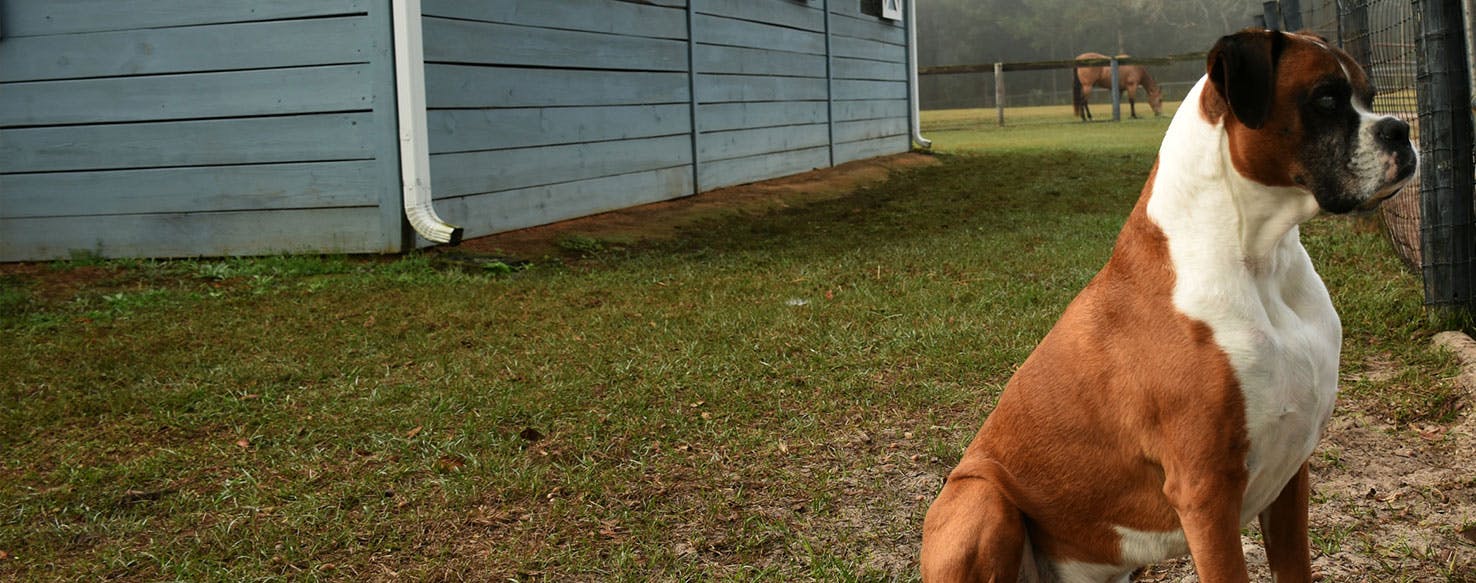- Home
- The Daily Wag!
- Behavior
- Why Do Boxer Dogs Stand Over You

Common
Irregular
We all know Boxers are the all-around family pet that absolutely craves human companionship and loves to be around children. At the same time, the Boxer breed can be stubborn and aggravating, having a strong-willed mind of his own. You might have noticed this in their relationship with other dogs or even in the way they relate to you. Some Boxers will try to stand over their owners or even sit on top of each other in an attempt to display their higher-ranking pack status. Has this ever happened to you? Let’s dig deeper into the subject and find out what you can do about your Boxer’s self-imposing dominant behavior.
While Boxer pups in a litter will pile up on top of each other for both warmth and security, the same cannot be said about their desire to stand over you. Sometimes it can be difficult to pinpoint the exact reason why your Boxer feels this way. What if he is only trying to reach for the window and get a better view of what’s happening outside or he is just wanting to be closer to you? In many cases, dogs who try to sit on their owners are simply displaying a pack behavior. In other words, they feel the need to be next to you and to be included. But the idea of standing over you stems from completely different reasons. A Boxer who has an inclination to stand up on your lap when you're sitting down may be displaying classic dominant patterns.
How do you recognize a dominant dog? Be careful about the behaviors that accompany this type of reaction in your Boxer, such as pushing through doors, pawing at you, trying to be physically taller than you, reluctance to move from a spot you want to sit on, reluctance to obey simple commands, or any attempt to shove you out of the way when walking or sitting next to you. Another thing to be mindful of is not confusing dominance with aggression. Dominance is a desire to run things, while aggression is the desire or intent to cause harm. A dominant Boxer will think he is the boss and try to run things his own way, regardless of your approval. You could say it’s in their genes, as wolves, foxes, coyotes, and their other wild cousins display the same type of behavior out in the wild. Canines naturally rank everyone they interact with as either higher ranking or lower ranking than themselves, so you need to be careful about the way you handle this issue.
Need advice about your pet's health?
Get answers fast from a veterinary professional 24/7 in the Wag! App.
Get Vet ChatRecognizing the first signs of dominant behavior is essential to changing the relationship between you and your Boxer. If by general rule, they are pushy, unresponsive to training, and lack proper house manners, you know you are dealing with a classic case of “doggie dominance.” But don’t worry just yet… all is not lost for your Boxer pup. Even if he’s no longer a puppy, there are plenty of things you can and need to do to “straighten” him out. This brings us to our first recommendation, which is to not show any sign of anger toward your dog when you’re trying to control his dominant reaction.
Dominant behavior in dogs is the natural result of their having no concept of equality. So do not get so pushy yourself that the dog feels the need to defend its position physically, it will only make the situation worse. You need to reinforce obedience training on your Boxer so that he always treats you as his master and not an ordinary, lesser-ranking member of the pack. Some of the things that you can do are making sure you get to eat first before you turn to feed him, teach him how to sit or down-stay while food is being put down, go through all doors first, and most importantly, physically force your dog to move away or out of your way, in a firm but not rough manner.
If the problem persists or worsens, consider speaking to a veterinarian to get recommendations for a qualified pet behaviorist in your area. Especially if your Boxer shows signs of both aggression and dominance, it can be hard to deal closely with this type of mixed behavior. Which is why contacting your vet or the local animal shelter can help with searching for references about professional animal behaviorists that live close to you. It’s important that you don’t overlook the issue and take action when you recognize the first signs of dominance in your pup. You will need to make yourself the Alpha dog, especially during leash training, and show him that you always mean what you say.
While many Boxers can show signs of dominance or aggression toward other dogs or family pets, they can also display the same type of behavior toward their owners. You will need to come up with a strict training process for your pup, especially in the first year of his life, if you want to avoid these issues later on. Obedience training and professional intervention are your most valuable allies in teaching your Boxer his ranking pack status.
Written by a Amstaff lover Marieta Murg
Veterinary reviewed by:
Published: 05/09/2018, edited: 01/30/2020
More articles by Marieta Murg

